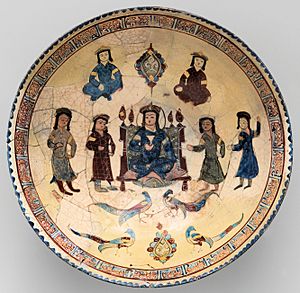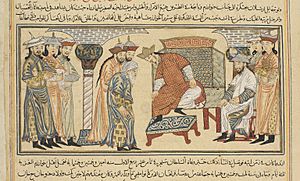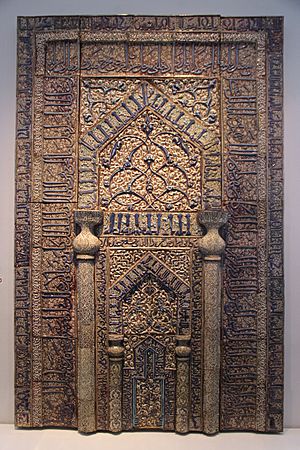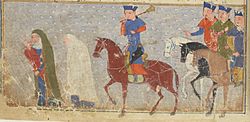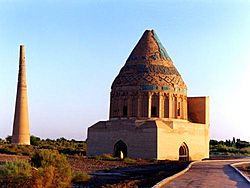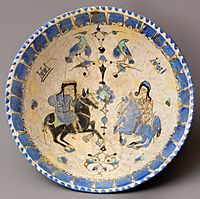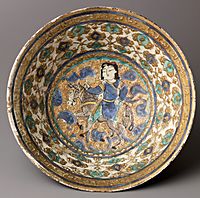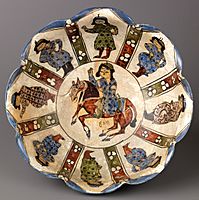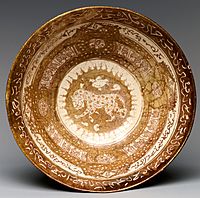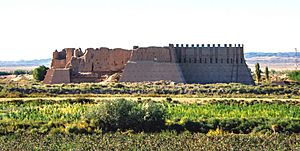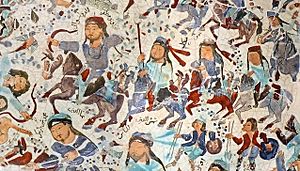Khwarazmian Empire facts for kids
Quick facts for kids
Khwarazmian Empire
خوارزمشاهیان
Khwārazmshāhiyān |
|||||||||||||||||||||||
|---|---|---|---|---|---|---|---|---|---|---|---|---|---|---|---|---|---|---|---|---|---|---|---|
| c. 1077–1231 | |||||||||||||||||||||||
| Status | Empire | ||||||||||||||||||||||
| Capital | Gurganj (1077–1212) Samarqand (1212–1220) Ghazna (1220–1221) Tabriz (1225–1231) |
||||||||||||||||||||||
| Largest city | Shahr-e Ray | ||||||||||||||||||||||
| Common languages | Persian (official, court, spoken) Arabic (theology, numismatics) Kipchak Turkic (dynastic, spoken) Oghuz Turkic (spoken) |
||||||||||||||||||||||
| Religion | Sunni Islam | ||||||||||||||||||||||
| Government | Absolute monarchy | ||||||||||||||||||||||
| Khwarazmshah | |||||||||||||||||||||||
|
• 1077–1096/7
|
Anushtegin Gharchai | ||||||||||||||||||||||
|
• 1220–1231
|
Jalal ad-Din Mingburnu | ||||||||||||||||||||||
| Historical era | Medieval | ||||||||||||||||||||||
|
• Established
|
c. 1077 | ||||||||||||||||||||||
| 1219–1221 | |||||||||||||||||||||||
|
• Battle of Yassıçemen
|
1230 | ||||||||||||||||||||||
|
• Disestablished
|
1231 | ||||||||||||||||||||||
| Area | |||||||||||||||||||||||
| 1210 est. or | 2,300,000 km2 (890,000 sq mi) | ||||||||||||||||||||||
| 1218 est. | 3,600,000 km2 (1,400,000 sq mi) | ||||||||||||||||||||||
| Population | |||||||||||||||||||||||
|
• 1220
|
5,000,000 | ||||||||||||||||||||||
| Currency | Dirham | ||||||||||||||||||||||
|
|||||||||||||||||||||||
The Khwarazmian Empire was a powerful empire in Central Asia. It existed from about 1077 to 1231. The empire was known for its Persian culture and Sunni Islam religion. Its rulers were of Turkic origin.
At first, the Khwarazmians were like helpers (called vassals) to bigger empires. These included the Seljuk Empire and the Qara Khitai. But around 1190, they became independent rulers.
The Khwarazmian Empire grew to be very strong. It defeated the Seljuk and Ghurid Empires. It even became the "greatest power" in the Muslim world in the early 1200s. At its largest, the empire covered a huge area. It was between 2.3 million and 3.6 million square kilometers. This made it one of the largest land empires in history.
The empire had a large army of horsemen. Most of these soldiers were Kipchak Turks. The Khwarazmian Empire was the last big Turco-Persian empire. It existed before the Mongol invasion of Central Asia. In 1219, the Mongols attacked. Their leader, Genghis Khan, conquered the empire in just two years. This was one of the bloodiest wars in human history.
The Khwarazmian dynasty was started by Anush Tigin. He was a Turkic slave who became a soldier (called a Mamluk) for the Seljuks. However, it was Ala ad-Din Atsiz, a later ruler, who made Khwarazm truly independent.
Contents
History of the Khwarazmian Empire
Early Beginnings
The title of Khwarazmshah was first used in 305 AD. It was brought back later. In 1017, there was a rebellion in Khwarazm. The rebels killed the ruler, Abu'l-Abbas Ma'mun. In response, Ghaznavid sultan Mahmud invaded the area. He put a new ruler in charge. Khwarazm then became part of the Ghaznavid empire until 1034.
In 1077, the Seljuqs took control of the region. They gave it to Anushtegin Gharchai. He was a Turkic mamluk commander. In 1097, another governor, Ekinchi ibn Qochqar, declared independence. He called himself the shah of Khwarazm. But he was soon killed. The Seljuqs then put Anush Tigin's son, Qutb al-Din Muhammad, in power. Qutb al-Din became the first ruler whose family would continue to rule Khwarazm.
Rise to Power
Anushtegin Gharachai's Role
Anushtegin Gharachai was a Turkic commander. He was the governor of Khwarazm from about 1077 to 1097. He was the first person from his family to rule Khwarazm. The dynasty that ruled after him was named after him.
Anushtegin was given command by the Seljuq sultan Malik-Shah I in 1073. His job was to take back land from the Ghaznavids. He also became the sultan's tasht-dar, which meant "keeper of the royal vessels." The money from Khwarazm was used to pay for this job. So, he became the governor of the province. He died by 1097. His son, Qutb al-Din Muhammad, took over.
Ala ad-Din Atsiz's Leadership
Atsiz became ruler after his father Qutb al-Din died in 1127. At first, he worked to protect Khwarazm from attacks by nomads. In 1138, he rebelled against his ruler, the Seljuq sultan Ahmad Sanjar. Atsiz was defeated and had to run away. Sanjar put his nephew, Suleiman Shah, in charge of Khwarazm.
But Atsiz came back, and Suleiman Shah could not keep control. Atsiz then attacked Bukhara. By 1141, he gave in to Sanjar again. Sanjar forgave him and gave him back control of Khwarazm. In the same year, the Kara Khitai defeated the Seljuqs in the Battle of Qatwan. Atsiz used this chance to invade Khorasan. He took over Merv and Nishapur.
However, the Kara Khitai sent an army to attack Khwarazm. This forced Atsiz to pay them a yearly tribute. In 1142, Sanjar drove Atsiz out of Khorasan. Sanjar then invaded Khwarazm and made Atsiz his vassal again. Atsiz was a smart ruler. He managed to deal with both the powerful Seljuk Sultan Sanjar and the Kara Khitai ruler Yelü Dashi. He added more land to Khwarazm. By the end of his life, Atsiz had made Khwarazm truly independent from its neighbors.
Expanding the Empire
Il-Arslan and Tekish's Reigns

Il-Arslan ruled Khwarazm from 1156 to 1172. He was the son of Atsïz. His father had made him governor of Jand. When Atsiz died in 1156, Il-Arslan became Khwarazmshah. Like his father, he paid tribute to both the Seljuk sultan Sanjar and the Qara Khitai.
Sanjar died a few months after Il-Arslan became ruler. This caused problems in Seljuq Khurasan. Il-Arslan used this to become more independent from the Seljuks. He also tried to expand his power in Khurasan.
In 1158, Il-Arslan got involved with the Karakhanids of Samarqand. They were another state that paid tribute to the Qara Khitai. Il-Arslan invaded their lands, took Bukhara, and surrounded Samarqand. The Qara Khitai sent an army, but it did not fight the Khwarazmians.

In 1172, the Qara Khitai attacked Il-Arslan. He had not paid his yearly tribute. The Khwarazmian army was defeated. Il-Arslan died soon after. His death led to a fight between his sons, Tekish and Sultan Shah. Tekish won and ruled the empire from 1172 to 1200.
Tekish continued his father's plans to expand the empire. Even though the Qara Khitai helped him become ruler, he later broke away from them. He also stopped a Qara Khitai invasion of Khwarazm. Tekish worked closely with Turkic tribes from the Aral Sea area. He hired many of them for his conquests in Iran. These tribes were known for being fierce fighters.
In 1194, Tekish defeated the Seljuq sultan Toghrul III. He did this with the help of Caliph Al-Nasir. Tekish then took over the sultan's lands. After the war, he had problems with the Caliphate. But in 1198, the Caliph accepted him as the sultan of Iran, Khorasan, and Turkestan. Tekish died in 1200. His son, Ala ad-Din Muhammad, took over. After Tekish died, there were revolts and killings of the Khwarazmian soldiers in Iran.
The Mongol Invasion
Ala al-Din Muhammad's Reign
Muhammad became ruler after his father Tekish died. Under Muhammad, the Khwarazmian Empire reached its largest size. He took over the western part of the Ghurid Empire in 1215. He also conquered the Western Kara-Khanid Khanate in 1213.
In 1218, a small group of Mongols crossed the borders. They were chasing an enemy general. After catching him, Genghis Khan tried to start trade with the Shah. But Muhammad II had heard exaggerated stories about the Mongols. He thought Genghis Khan's offer was a trick to invade Khwarazm.
Genghis Khan sent messengers to the Shah. He wanted to show he hoped for peaceful trade. But Muhammad II's governor, Inalchuq, accused the messengers of spying. He took their goods and arrested them.
Genghis Khan tried again to keep peace. He sent three men to the Shah. He gave Muhammad II a chance to say he knew nothing about the governor's actions. He also asked the Shah to hand over the governor for punishment. But the Shah had the messengers killed. He then ordered all Mongol and Muslim merchants to be killed and their goods taken.
These actions made Genghis Khan furious. He attacked with an army of 100,000 to 150,000 men. In 1219, they crossed the Jaxartes river. They destroyed cities like Samarqand, Bukhara, and Otrar. Muhammad's capital city, Gurganj, was also destroyed. Shah Muhammad II of Khwarazm ran away. He died a few weeks later on an island in the Caspian Sea.
Turkan Khatun's Influence
Before the Mongol invasion, the Khwarazmian Empire had two main leaders. Khwarazmshah Muhammad II was the official ruler. But his mother, Turkan Khatun, was also very powerful. She even had the title "Ruler of the World." Her orders were so important that the Sultan's orders needed her signature to be official. She had her own government department and palace. Her disagreements with Muhammad II might have weakened the empire. This made it easier for the Mongols to conquer them.
In 1221, Genghis Khan's troops captured Turkan Khatun. She died in poverty in Mongolia.
Jalal ad-Din Mingburnu's Last Stand
Jalal ad-Din was the last Khwarazmshah. He ruled the remaining parts of the empire and northwestern India from 1220 to 1231. He was the oldest son of Ala ad-Din Muhammad II. His grandmother, Terken Khatun, did not want him to be ruler. She preferred his half-brother.
Jalal ad-Din tried to escape to India. But the Mongols caught him. He was defeated at the Battle of Indus. He managed to escape again and asked for safety in the Sultanate of Delhi. However, the Sultan of Delhi refused to help him.
Jalal ad-Din returned to Persia. He gathered an army and started a new kingdom. But he could never fully control it. He spent his last years fighting the Mongols, the Seljuks of Rum, and others who wanted his throne. He lost control of Persia in a battle against the Mongols. He escaped to the Caucasus. In 1225, he captured Azerbaijan and made Tabriz his capital. In 1226, he attacked Georgia and destroyed Tbilisi.
He then fought the Ayyubids in the Armenian highlands. He captured the town of Ahlat. The Ayyubids asked the Seljuq Sultanate of Rûm for help. Sultan Kayqubad I defeated Jalal ad-Din at the Battle of Yassıçemen in 1230. Jalal ad-Din escaped to Diyarbakir. The Mongols then conquered Azerbaijan. In 1231, Kurdish highwaymen murdered him.
Government and Administration
The main leader of the Khwarazmian government was the vizier. The vizier was the first advisor to the Khwarazmshah. He was in charge of government officials. He appointed them, set their salaries, and managed taxes. A famous vizier was Al-Harawi. He built a mosque, a large school, and a library in Gurganj.
Another important position was the senior hajib. This person was usually from the Turkic nobility. The hajib reported to the Khwarazmshah about issues related to the ruler and his family. The Khwarazmshah could have several hajibs. They carried out the sultan's personal instructions.
Capital Cities
The first and most important capital of the Khwarazmian Empire was Urganch or Gurganj. A famous geographer, Yaqut al-Hamawi, visited Gurganj in 1219. He wrote, "I have not seen a city greater, richer and more beautiful than Gurganj." Another writer, Al-Qazvini, described Gurganj as a very beautiful city. He said its people were skilled craftspeople, especially blacksmiths and carpenters. They were also famous for their carvings made from ivory and ebony.
Later, the cities of Samarqand, Ghazna, and Tabriz also served as capitals for the Khwarazmian Empire.
Population and People

The people of the Khwarazmian Empire were mainly Iranian people who lived in cities. There were also half-nomadic Turkic peoples.
Most of the empire's people lived in a few very large cities. Historians believe about 5 million people lived in the empire in 1220. This was just before the Mongol invasion. The population was spread out over a very large area.
Here are some estimated populations for the major cities around the early 13th century:
- Samarqand: 80,000–100,000 people
- Nishapur: 70,000 people
- Rayy/Rey: 100,000 people
- Isfahan: 80,000 people
- Merv: 70,000 people
- Balkh: about 30,000 people
- Bost: about 40,000 people
- Herat: about 40,000 people
The populations for Otrar, Urgench, and Bukhara are unknown, but they were likely less than 70,000 each.
Culture and Art
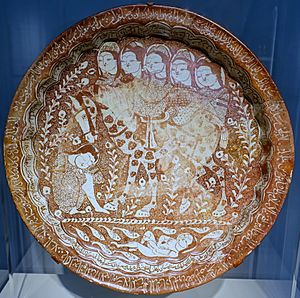
Even though the Khwarazmshahs were of Turkic origin, they adopted Persian culture. They followed the Sunni branch of Islam. Their richest cities were in Khorasan, a Persian region. So, the Khwarazmshah era had a mix of Turkic origins and high Persian culture.
Languages Spoken
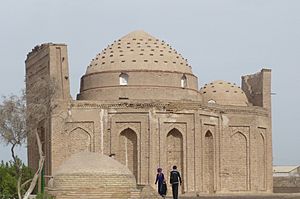
During the Khwarazmshah era, Central Asian society was quite mixed. The Khwarazmian army was mostly made up of Turks. But the government and civilian people were almost all Persian. The Turkic people in Khwarazm spoke Kipchak Turkic and Oghuz.
However, the main language of the time was Persian. Most people in the important Khwarazmian cities spoke Persian. The government also used Persian. Its members needed to know Persian culture well. Persian became the official language of the Khwarazmshahs. It was used for government, history, stories, and poems. The Turkic language was the family language of the rulers. Arabic was mainly used for science, philosophy, and religious studies.
Ceramics and Art
Beautifully decorated Mina'i ceramics were made mainly in Kashan, Iran. This was in the decades before the Mongol invasion of Persia in 1219. The Khwarazmian Empire ruled the area at this time. Some of the most famous pottery pieces are from the time of the Khwarazmian rulers. Mina'i ware was made from the late 12th century to the early 13th century. Dated pieces range from 1186 to 1224. Many lusterware pieces also come from this period.
-
Lusterware bowl with leopard, early 13th century, Kashan, Iran Dated examples are also known.
Military Strength
Before the Mongol invasion, the Khwarazmian army had about 40,000 horsemen. Most of these soldiers were of Turkic origin. The major cities of Khwarazm also had local militias. However, these militias were not very well trained or equipped. The major cities had about 700,000 people in total. This means there were probably 105,000 to 140,000 healthy men who could fight. But only a small part of them were in a formal, well-trained militia.
Khwarazmian Mercenaries
After the Mongol invasion, many Khwarazmians became soldiers for hire (mercenaries). They found work in northern Iraq. Sultan Jalal ad-Din's followers stayed loyal to him even after he died in 1231. They raided lands in Jazira and Syria for several years. They called themselves the Khwarazmiyya.
Later, the Ayyubid Sultan as-Salih Ayyub in Egypt hired them. He used them against his uncle. The Khwarazmiyya traveled south from Iraq towards Egypt. On their way, on July 11, 1244, they invaded Crusader-held Jerusalem (Siege of Jerusalem (1244)). The city's fortress, the Tower of David, surrendered on August 23. The Christian people living in the city were forced to leave.
This event led to a call for the Seventh Crusade from Europe. But the Crusaders never took Jerusalem back. After the Khwarazmian forces conquered it, the city remained under Muslim control. It stayed that way until 1917, when the British took it from the Ottomans.
After taking Jerusalem, the Khwarazmian forces continued south. On October 17, 1244, they fought alongside the Ayyubids at the Battle of La Forbie. This battle destroyed the remaining Crusader army. About 1,200 knights were killed. It was the biggest battle involving the Crusaders since the Battle of the Horns of Hattin in 1187.
See also
 In Spanish: Imperio jorezmita para niños
In Spanish: Imperio jorezmita para niños
- List of Sunni Muslim dynasties


